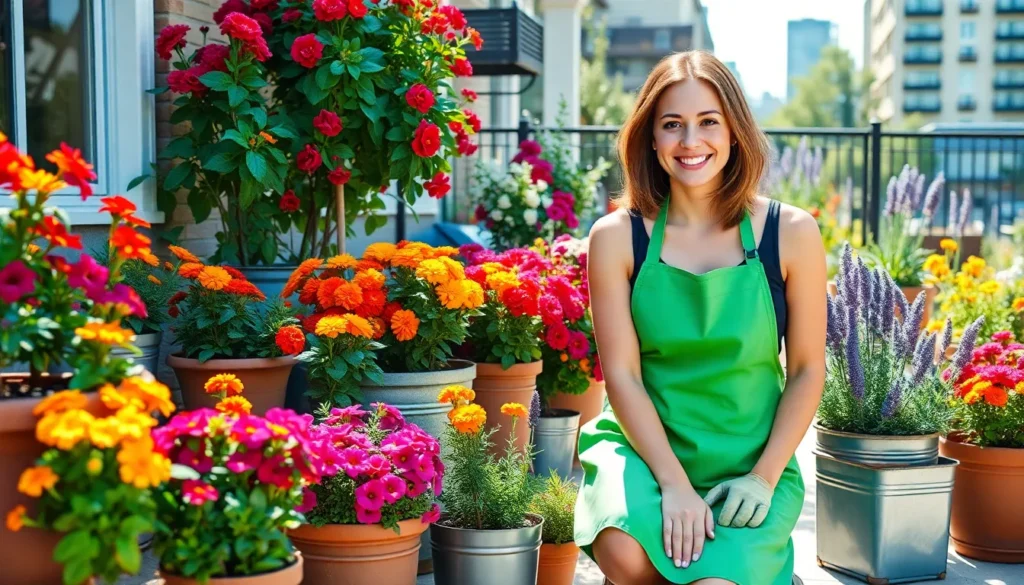Transform any space into a blooming paradise with container gardening – the perfect solution for apartment dwellers city gardeners and anyone who wants gorgeous flowers without the commitment of traditional beds. We’ve discovered that container gardens offer incredible flexibility letting you move displays around experiment with different combinations and bring color to patios balconies and even indoor spaces.
Container flower gardening isn’t just about throwing seeds in pots. It’s an art form that combines creativity with smart plant selection. We’ll show you how to choose the right containers pair complementary flowers and create stunning arrangements that bloom throughout the seasons.
Whether you’re working with a tiny balcony or a sprawling deck we’ve compiled the most effective flower combinations and design strategies that guarantee showstopping results. From cascading petunias to vibrant marigolds these container gardening ideas will turn your space into the neighborhood’s most envied garden spot.
Choose the Right Containers for Your Flower Garden
Selecting proper containers sets the foundation for thriving container flower gardens. We’ll explore the essential factors that determine success in your flowering displays.
Size and Drainage Requirements
Container size directly impacts plant health and flowering potential. We recommend minimum depths of 6-8 inches for shallow-rooted flowers like marigolds and petunias. Deeper flowers such as sunflowers and dahlias require containers at least 12-18 inches deep to accommodate their extensive root systems.
Drainage holes prevent root rot and waterlogged soil conditions. We ensure every container has multiple drainage holes spaced 2-3 inches apart across the bottom. Clay pots naturally provide excellent drainage, while plastic containers may need additional holes drilled for proper water flow.
Width considerations affect root spread and visual impact. We choose containers that are at least as wide as they are deep for most flowering plants. Hanging baskets work best with 12-14 inch diameters to support trailing flowers like bacopa and lobelia.
Material Options and Their Benefits
Terracotta pots offer superior breathability for healthy root development. We love how these clay containers naturally regulate soil moisture while providing excellent drainage. Their porous nature prevents overwatering issues common with beginner container gardeners.
Plastic containers provide lightweight portability and moisture retention. We use these for seasonal displays that need frequent repositioning. High-quality resin planters resist fading and cracking while maintaining their appearance through multiple growing seasons.
Wooden planters create rustic charm while offering natural insulation. We recommend cedar or teak varieties that resist rot and insect damage. These containers work exceptionally well for cottage garden flower combinations and herb-flower pairings.
Metal containers add modern aesthetic appeal to contemporary spaces. We choose galvanized steel or powder-coated aluminum for durability. These materials heat up quickly in direct sunlight, making them ideal for sun-loving flowers like zinnias and cosmos.
Decorative Versus Functional Considerations
Decorative containers enhance visual appeal but may compromise plant health. We balance style with functionality by ensuring decorative pots have adequate drainage and appropriate sizing. Glazed ceramic pots look stunning but often lack proper drainage holes.
Functional containers prioritize plant health over aesthetic appeal. We start with basic nursery pots or utilitarian planters when growing flowers for cutting gardens. These practical choices allow us to focus resources on soil quality and plant selection.
Cachepots offer the perfect compromise between beauty and function. We place functional growing containers inside decorative outer pots without drainage. This system allows easy watering management while maintaining attractive displays throughout our container flower arrangements.
Color coordination creates cohesive garden designs. We select container colors that complement our flower palette rather than competing with blooms. Neutral tones like terracotta, white, or charcoal allow flowers to remain the focal point in our container compositions.
Select Annual Flowers for Continuous Blooms
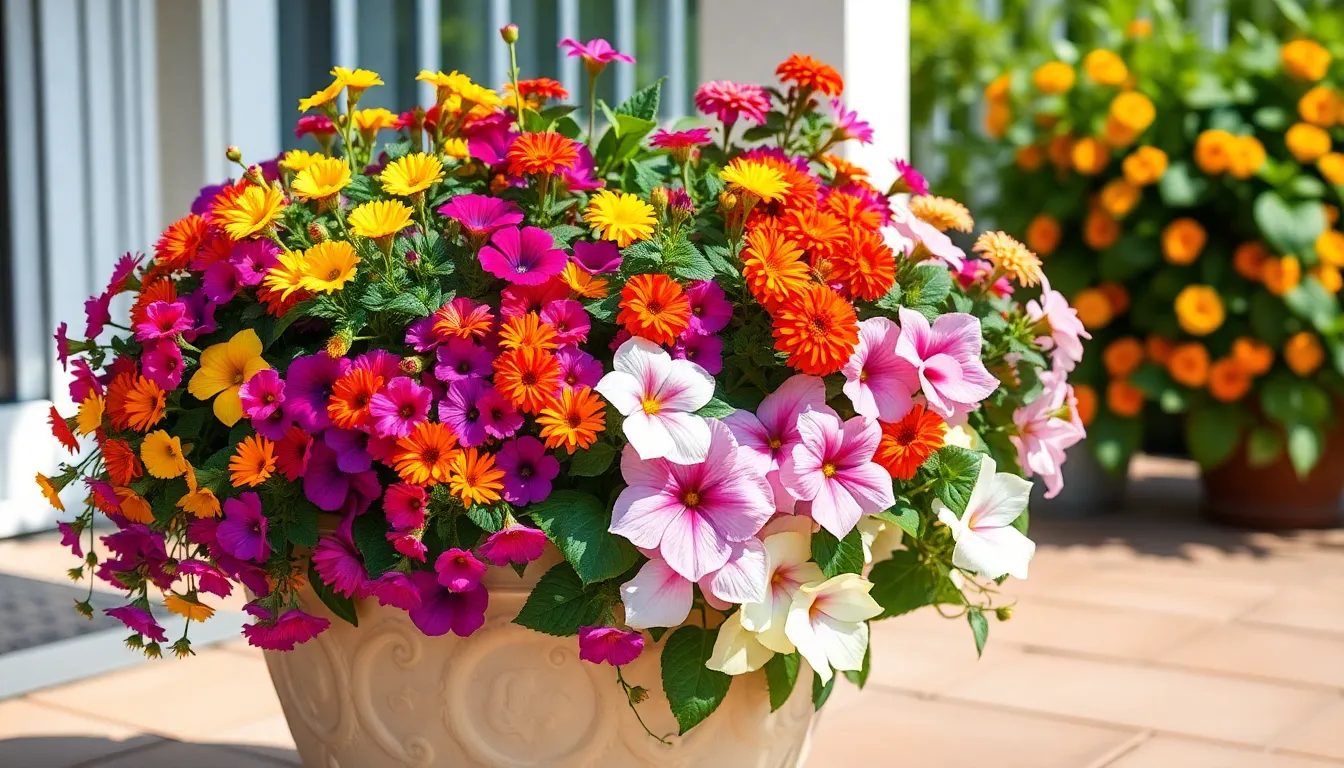
Annual flowers provide the foundation for spectacular container displays that bloom from spring through fall. We’ve found that choosing varieties bred for extended flowering periods eliminates the need for constant replanting and ensures your containers stay vibrant all season long.
Petunias for Cascading Color
Petunias create stunning waterfall effects when planted in hanging baskets or tall containers. These popular annuals produce an abundance of trumpet-shaped blooms in vibrant shades of purple, pink, red, white, and yellow that cascade gracefully over container edges.
Growing petunias requires full sun to partial shade and well-draining soil that stays consistently moist. Regular deadheading encourages continuous blooming, though newer varieties like Wave and Supertunia series bloom non-stop without this maintenance. We recommend pinching back leggy stems mid-season to promote bushier growth and more flowers.
Combining petunias with upright plants like snapdragons creates ever-changing visual interest in large containers. The trailing habit of petunias softens container edges while providing months of color that attracts butterflies and hummingbirds to your garden space.
Marigolds for Low-Maintenance Beauty
Marigolds offer foolproof success for beginning container gardeners with their bright yellow and orange blooms that thrive in challenging conditions. These hardy annuals tolerate heat, drought, and poor soil while producing flowers continuously from spring until the first frost.
French marigolds work best in containers due to their compact 6-12 inch height, while African marigolds can reach up to 3 feet tall in large pots. Both varieties repel harmful insects naturally, making them excellent companion plants for vegetable containers or mixed flower arrangements.
Planting marigolds requires minimal care once established in full sun locations with average garden soil. We suggest deadheading spent blooms weekly to encourage new flower production, though this isn’t strictly necessary for continuous blooming. Water deeply but infrequently to prevent root rot and fungal diseases.
Impatiens for Shady Locations
Impatiens transform shaded patios and covered porches into colorful garden retreats where most flowering plants struggle to bloom. These shade-loving annuals produce masses of flat-faced flowers in soft pastels and bright jewel tones that brighten dark corners from late spring through fall.
Standard impatiens perform best in partial to full shade with consistently moist, well-draining soil rich in organic matter. New Guinea impatiens tolerate more sun and feature larger flowers with variegated foliage that adds extra visual appeal to container arrangements. Both types require protection from strong winds that can damage their succulent stems.
We’ve discovered that impatiens pair beautifully with ferns, caladiums, and begonias in large shade containers. Regular watering keeps these moisture-loving plants happy, while monthly feeding with balanced fertilizer promotes abundant blooming throughout the growing season.
Plant Perennial Flowers for Long-Term Investment
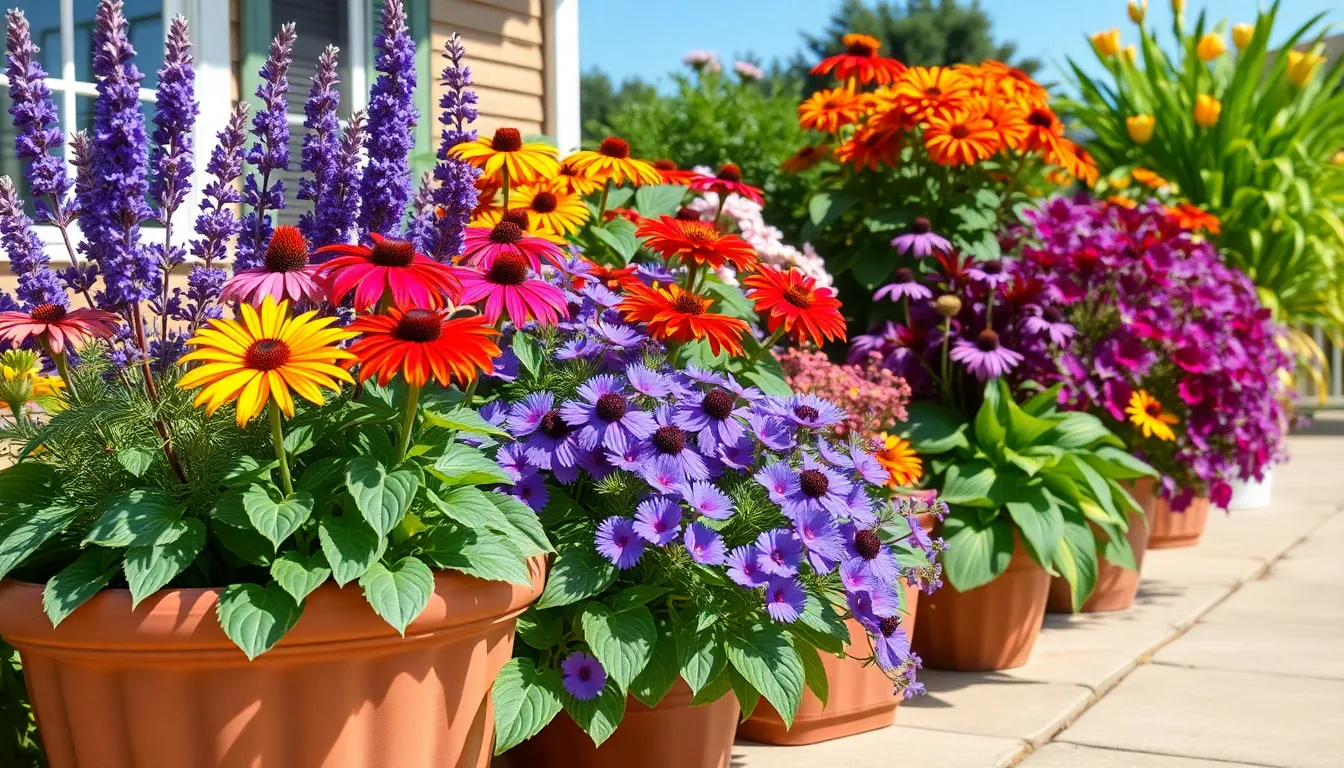
Perennial flowers offer exceptional value for container gardeners who want beautiful displays that return year after year. These hardy plants establish strong root systems and provide ongoing blooms with minimal replanting effort.
Lavender for Fragrance and Texture
Lavender transforms any container display with its distinctive silvery foliage and aromatic purple spikes. Full sun exposure brings out the best in these Mediterranean natives, making them perfect for sunny patios and balconies.
Drought tolerance makes lavender an ideal choice for busy gardeners who can’t water daily. The fragrant oils in both flowers and leaves create a sensory experience that attracts beneficial pollinators while deterring pests naturally.
We recommend pairing lavender with other sun loving perennials like ornamental grasses or rosemary for a cohesive Mediterranean themed container. The plant’s compact growth habit works well in medium sized pots, typically 12 to 16 inches in diameter.
Black-Eyed Susans for Native Appeal
Black-Eyed Susans bring vibrant yellow petals with distinctive dark centers to container gardens throughout summer months. Native to North America, these resilient perennials adapt well to various growing conditions while supporting local wildlife.
Drought tolerant nature means these flowers thrive even when water becomes scarce during hot summer periods. The bright yellow blooms create stunning contrast when paired with purple flowers like salvia or deep green foliage plants.
Container size should accommodate their mature spread of 12 to 18 inches, making them suitable for larger pots or as centerpiece plants in mixed arrangements. We find they perform best with at least 6 hours of direct sunlight daily.
Hostas for Foliage Interest
Hostas excel in shaded container locations where most flowering plants struggle to perform. Partial sun to full shade exposure makes them perfect for covered porches, north facing balconies, or under tree canopies.
Attractive foliage comes in various sizes, colors, and patterns, from small blue green varieties to large chartreuse specimens with white margins. Summer blooms add bonus interest with tall spikes of white or lavender flowers.
Low maintenance requirements make hostas ideal for beginning container gardeners who want impressive results without intensive care. We suggest combining different hosta varieties with ferns and coral bells to create layered shade gardens that provide visual interest throughout the growing season.
Design Thriller, Filler, and Spiller Combinations
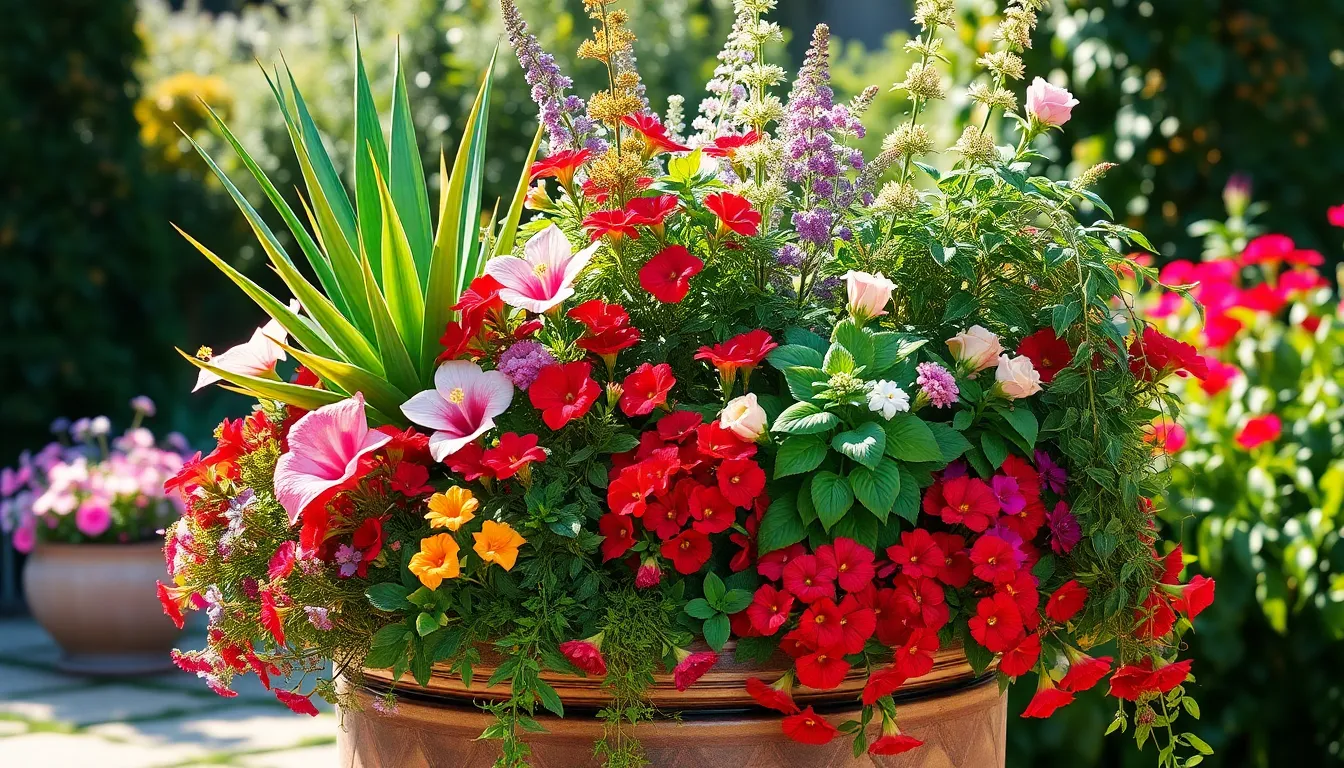
We’ll now explore one of the most effective design strategies that transforms ordinary containers into stunning focal points. This proven three-layer approach creates balanced arrangements with professional-looking results.
Creating Height with Thriller Plants
Thriller plants serve as our container’s centerpiece, providing the dramatic vertical element that catches the eye first. We position these tall, architectural specimens in the center or back of our arrangements to establish the overall scale and visual impact.
Agave creates striking sculptural drama with its bold, succulent leaves that demand attention in any container design. Canna delivers tropical flair through vibrant foliage and spectacular flower spikes that can reach impressive heights. Purple Fountain Grass adds graceful movement with its flowing, burgundy-tinted plumes that sway beautifully in gentle breezes.
Hibiscus produces dinner-plate-sized blooms in brilliant colors that become instant conversation starters. Brugmansia, commonly known as Angel’s Trumpet, offers exotic appeal with its large, trumpet-shaped flowers that release intoxicating evening fragrance.
Adding Fullness with Filler Flowers
Filler plants bridge the gap between our thriller and spiller elements, creating the essential middle layer that gives our containers their lush, full appearance. We select these medium-height plants to complement our thriller while adding color, texture, and visual weight to the arrangement.
Coleus provides incredible foliage diversity with varieties showcasing burgundy, lime green, and multicolored leaves that maintain their beauty throughout the growing season. Petunias deliver continuous blooms in virtually every color imaginable, from soft pastels to bold, saturated hues. Begonias offer both flowering and foliage options, with wax begonias providing steady color and rex begonias contributing stunning leaf patterns.
Lobelia creates delicate clouds of tiny flowers in shades of blue, purple, white, and pink that soften the overall composition. These reliable performers fill spaces efficiently while maintaining the design’s visual flow.
Incorporating Trailing Spiller Varieties
Spiller plants complete our three-part formula by cascading gracefully over container edges, creating the soft, flowing lines that make arrangements appear naturally abundant. We use these trailing varieties to add movement and extend the visual impact beyond the container’s boundaries.
Sweet Potato Vine brings vibrant chartreuse or deep purple foliage that cascades dramatically, creating stunning color contrasts with other plants. Creeping Jenny offers bright golden-green leaves on trailing stems that spill beautifully from hanging baskets and tall containers.
Verbena produces clusters of small flowers in purple, pink, white, and red that trail gracefully while attracting butterflies to our gardens. Lobelia works double duty as both filler and spiller, depending on the variety, with trailing types creating delicate cascades of tiny blooms. Euphorbia adds unique textural interest with its distinctive growth habit and unusual foliage that creates striking contrasts with traditional flowering plants.
Consider Seasonal Flower Rotation Ideas
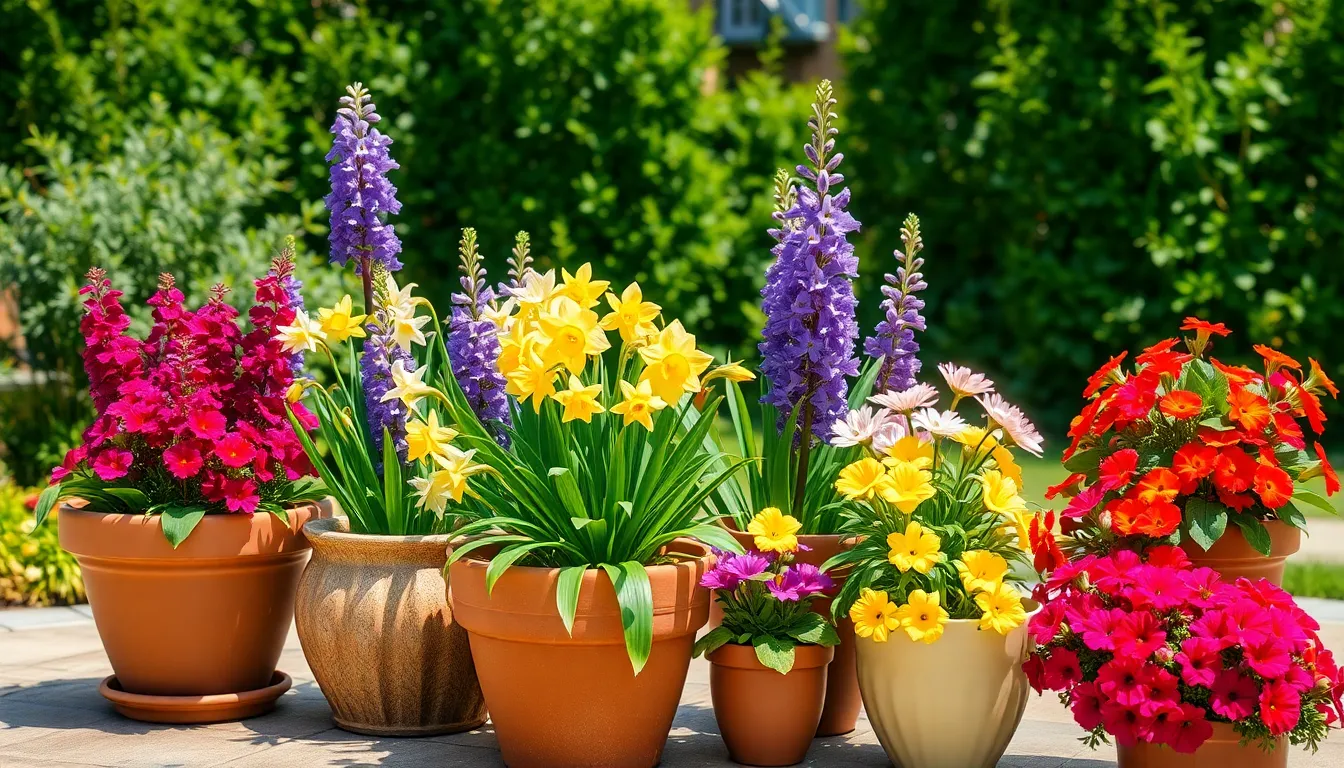
We can maximize our container garden’s visual impact by rotating flowers throughout the year, ensuring continuous color and interest across all seasons. This strategic approach allows us to enjoy fresh blooms while adapting to each season’s unique growing conditions.
Spring Bulb Container Displays
Daffodils create stunning spring displays in containers and offer exceptional value since they naturally increase over time. We love these resilient bulbs because they come in various colors and require minimal maintenance once established. Their container-friendly nature makes them perfect for those just starting their seasonal rotation journey.
Grape hyacinth pairs beautifully with taller daffodils, growing between 6 inches and a foot tall to create layered visual interest. These compact bulbs complement larger spring flowers while adding delicate texture to our arrangements. We can easily combine these two varieties for effortless spring color that returns year after year.
Planning spring containers in fall gives us the best results since most bulbs require cold treatment for proper blooming. We recommend planting containers in late October or November, then storing them in unheated garages or cold frames. This timing ensures spectacular spring displays when warmer weather arrives.
Summer Heat-Tolerant Options
Petunias deliver cascading color throughout summer months, with their trailing varieties creating lush displays in hanging baskets and tall containers. We particularly appreciate their continuous blooming habit and wide color range. Ensuring good drainage in containers keeps these summer favorites thriving even during intense heat periods.
Lantana attracts butterflies while withstanding scorching temperatures that challenge many other flowers. These vibrant clusters create focal points in our summer arrangements and require minimal watering once established. We find lantana especially valuable for sunny locations where other flowers struggle.
Zinnias thrive in warm weather and provide bold colors that energize our container displays during peak summer months. These easy-care flowers bloom continuously when we deadhead spent blossoms regularly. We can grow zinnias in containers of various sizes, making them versatile choices for different garden spaces.
Hibiscus creates tropical ambiance in larger containers, producing spectacular blooms that love intense summer heat. These plants require more water than other heat-tolerant options but reward us with dramatic flowers. We recommend using substantial containers to accommodate hibiscus root systems and water needs.
Fall Chrysanthemum Arrangements
Chrysanthemums offer diverse fall colors and serve as the foundation for autumn container displays that celebrate the season’s rich palette. These hardy flowers come in many varieties, from compact mounds to cascading forms. We can select from deep burgundies, golden yellows, and warm oranges to match our fall decorating themes.
Asters complement chrysanthemums perfectly by adding varied textures and extending our color options in fall arrangements. These flowers provide delicate, daisy-like blooms that contrast beautifully with mum’s fuller flowers. We often combine different aster varieties to create depth and visual interest in our autumn containers.
Ornamental cabbage and kale add texture to fall displays while providing cool-season color that intensifies as temperatures drop. These plants offer unique foliage patterns and colors that traditional flowers can’t match. We use them as foundation plants, then accent with flowering varieties for complete seasonal arrangements.
Plan for Different Light Conditions
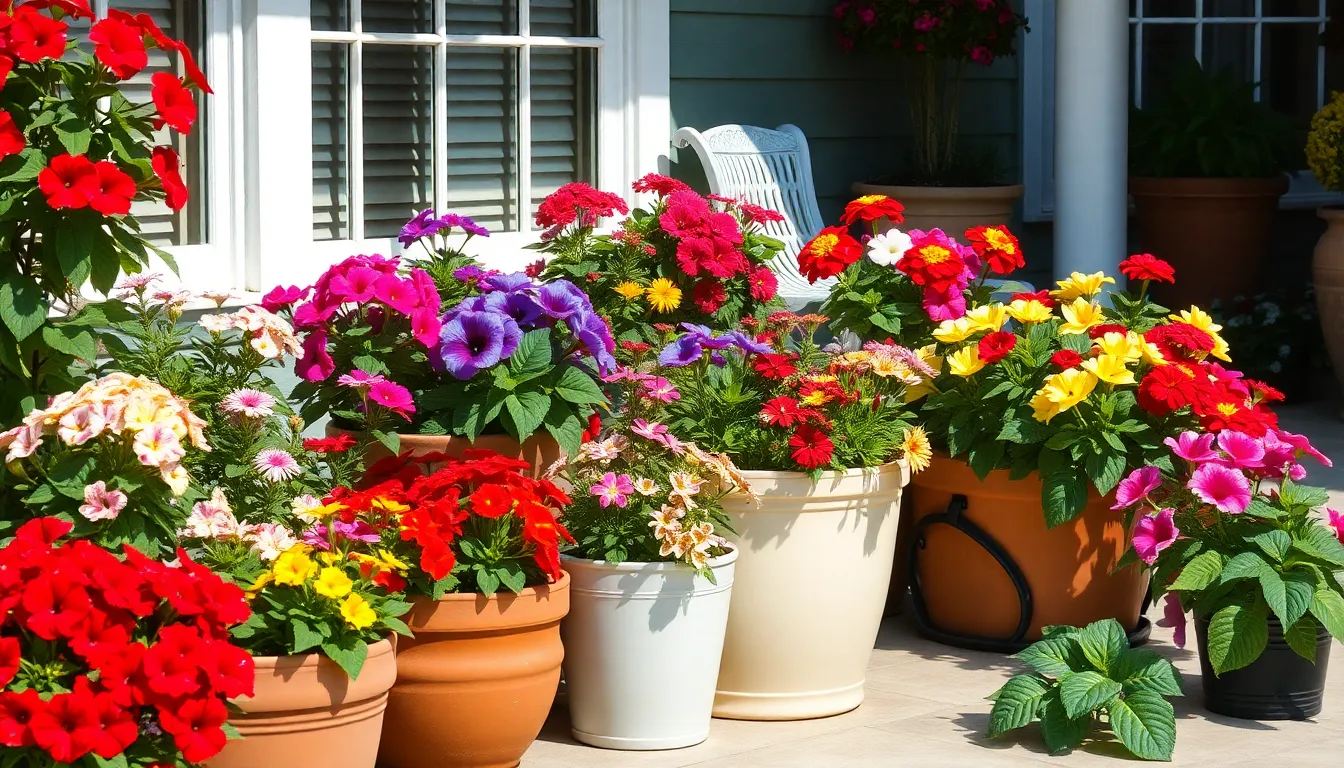
Understanding your space’s light conditions helps us select the perfect flowers for thriving container gardens. Different lighting environments require exact plant choices to ensure vibrant blooms and healthy growth throughout the season.
Full Sun Container Flower Ideas
Petunias cascade beautifully in hanging baskets and containers, creating stunning displays in sunny locations. Hybrid petunias particularly excel in full sun conditions while requiring excellent drainage to prevent root issues. We recommend pairing these colorful bloomers with complementary plants for maximum visual impact.
Geraniums deliver vibrant colors that brighten any sunny container arrangement. These classic flowers thrive in direct sunlight and offer consistent blooms throughout the growing season. Their sturdy nature makes them perfect companions for other sun loving varieties.
Zinnias bring bold, cheerful colors to full sun containers with minimal maintenance requirements. These hardy annuals bloom continuously in hot weather and attract beneficial pollinators to our gardens. We can combine them with other heat tolerant flowers for diverse color combinations.
Partial Shade Flowering Answers
Begonias flourish in partial shade conditions while providing diverse color options for our containers. These versatile flowers adapt well to changing light conditions throughout the day. We can choose from wax begonias for consistent blooms or tuberous varieties for dramatic displays.
Impatiens add vibrant splashes of color to partially shaded container gardens with ease. These reliable bloomers prefer morning sun and afternoon shade for optimal performance. We find them particularly effective when paired with foliage plants for textural contrast.
Coleus creates visual interest through colorful foliage rather than traditional flowers in partial shade settings. These plants offer countless color combinations from deep burgundy to bright lime green. We use them as filler plants to complement flowering varieties in mixed containers.
Deep Shade Container Options
Hostas provide beautiful foliage and occasional flower spikes in deep shade container gardens. These perennial favorites offer various leaf sizes, colors, and textures for year round interest. We appreciate their low maintenance requirements and ability to thrive in challenging lighting conditions.
Hellebores bloom during late winter and early spring in deep shade containers when few other flowers perform. These Christmas roses provide elegant flowers in white, pink, and burgundy shades. We value their early season interest and evergreen foliage that looks attractive year round.
Astilbe produces feathery, plume like blooms that brighten deep shade containers during summer months. These perennial flowers come in white, pink, red, and purple varieties for diverse color options. We recommend combining them with hostas and ferns for cohesive shade garden displays.
Create Theme-Based Container Gardens
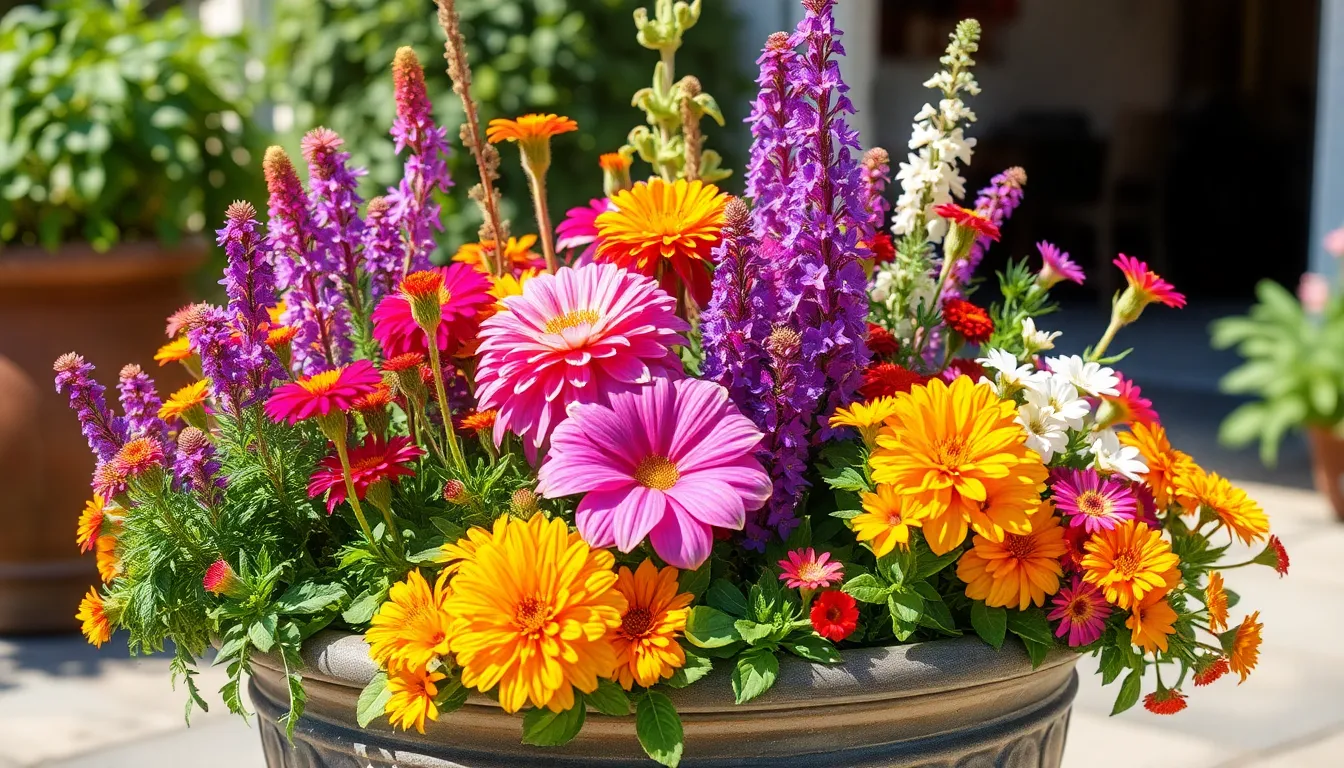
We can elevate our container gardening by organizing our flower selections around exact themes that reflect our personal style and garden goals.
Butterfly and Pollinator-Friendly Flowers
Agastache transforms our containers into vibrant pollinator havens with its fragrant spikes that bloom from summer through fall. These drought-tolerant beauties produce nectar-rich flowers in purple, pink, and orange hues that butterflies can’t resist.
Salvia varieties create stunning vertical interest while attracting both bees and butterflies to our container displays. We’ll find these perennials produce continuous blooms when we deadhead spent flowers regularly.
Lantana clusters deliver non-stop color throughout the growing season, offering small butterfly-friendly flowers in combinations of yellow, orange, red, and white. These heat-loving plants thrive in sunny locations and require minimal maintenance.
Alyssum provides early spring nectar sources when other flowers haven’t emerged yet. We can plant these low-growing annuals around taller plants to create a carpet of white and pink blooms that beneficial insects adore.
Celosia adds brilliant focal points with its distinctive flower heads in red, pink, yellow, and orange shades. These versatile annuals bloom continuously and attract both butterflies and beneficial insects to our themed containers.
Cottage Garden Style Combinations
Dianthus brings old-fashioned charm with its intensely fragrant flowers in white, pink, red, and burgundy tones. We can plant these perennials as edging plants or mix them with other cottage favorites for authentic appeal.
Chrysanthemum varieties extend our cottage garden season into late fall with their abundant daisy-like blooms. These hardy perennials come in countless colors and forms, from button types to large decorative varieties.
Peruvian Lily adds exotic touches to our cottage-style containers with its bright, spotted flowers that last for weeks in arrangements. We’ll appreciate how these bulbs multiply over time, creating fuller displays each season.
Traditional combinations work beautifully when we pair tall delphiniums with medium-height roses and low-growing sweet alyssum. This layered approach mimics the informal, abundant look of English cottage gardens.
Modern Minimalist Flower Arrangements
Monochromatic themes create sophisticated displays using different shades and textures of a single color family. We might choose various purple flowers like lavender, salvia, and verbena for a cohesive yet interesting arrangement.
Structural elements become focal points when we select plants with striking architectural forms like ornamental grasses or bold-leafed hostas. These dramatic shapes provide year-round interest even when flowers fade.
Limited color palettes make powerful statements using just two or three bold, contrasting colors like white and deep purple or yellow and burgundy. We’ll find these restrained combinations create more visual impact than busy, multicolored displays.
Clean lines and geometric containers enhance our minimalist approach when paired with simple plant selections. Square or rectangular planters work especially well for creating the structured look that defines modern garden design.
Maintain Your Container Flower Gardens
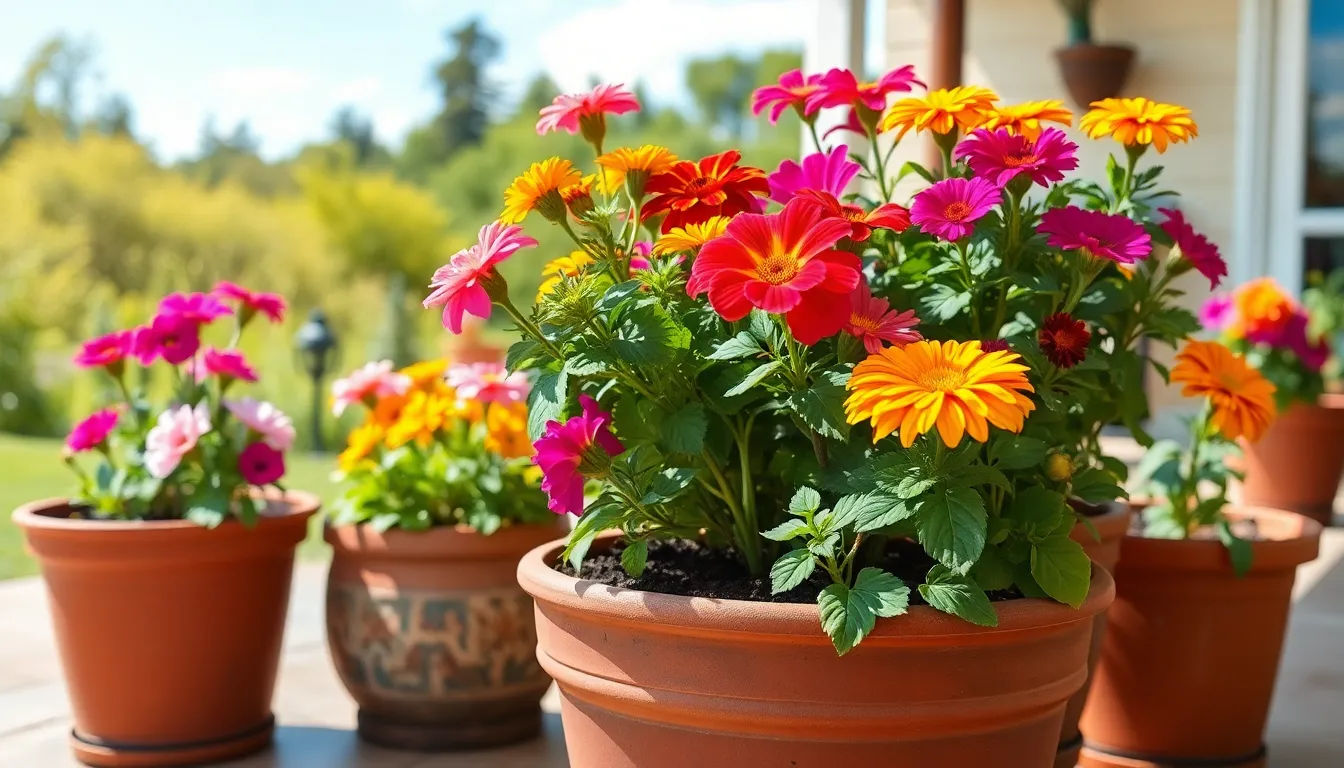
Now that we’ve created our stunning container displays, proper maintenance becomes essential for keeping our flower gardens thriving throughout the growing season. Regular care ensures our carefully planned arrangements continue to deliver the visual impact we designed them for.
Watering and Fertilizing Schedules
Daily soil moisture checks form the foundation of successful container flower care. We recommend testing the top inch of soil with our finger to determine when watering becomes necessary. Container gardens dry out faster than traditional garden beds, especially during hot summer months when temperatures soar above 80°F.
Consistent watering schedules prevent the stress that causes flowers to wilt and stop blooming. We water our containers when the top inch feels dry to the touch, typically every 1-2 days during peak summer heat. Early morning watering allows plants to absorb moisture before the day’s heat arrives, reducing evaporation and maximizing water efficiency.
Overwatering poses a greater threat to container flowers than underwatering. Root rot develops quickly in waterlogged soil, killing even the hardiest flowers like marigolds and petunias. We ensure our containers have adequate drainage holes and use well-draining potting mix to prevent water from accumulating around roots.
Weekly fertilizing during the growing season keeps our container flowers producing continuous blooms. Balanced fertilizers with equal parts nitrogen, phosphorus, and potassium provide the nutrients our flowers need without promoting excessive foliage growth. We dilute liquid fertilizer to half strength and apply it every 7-10 days for optimal results.
Slow-release fertilizer granules offer an alternative approach for busy gardeners. These granules release nutrients gradually over 3-4 months, reducing the frequency of fertilizing tasks while maintaining consistent nutrition for our flowers.
Deadheading and Pruning Techniques
Regular deadheading extends the blooming period of most annual flowers by 2-3 weeks. We remove spent flowers by pinching or cutting them just above the next flower bud or leaf node. This process redirects the plant’s energy from seed production back into creating new blooms.
Petunias benefit from aggressive deadheading every few days to maintain their cascading display. We pinch off faded flowers along with their stems, encouraging bushier growth and more abundant flowering. Marigolds respond similarly, producing fresh blooms within 5-7 days of deadheading.
Pruning techniques vary depending on the growth habits of our container flowers. Trailing plants like sweet potato vine require regular trimming to prevent them from overwhelming neighboring plants. We cut back excessive growth by one-third, maintaining the spiller effect while keeping proportions balanced.
Bushy flowers such as coleus and begonias benefit from light pruning to maintain their shape. We pinch growing tips when plants reach 6-8 inches tall, encouraging lateral branching that creates fuller, more attractive specimens. This technique works particularly well for thriller plants that serve as focal points in our arrangements.
Seasonal Care and Storage Tips
Winter storage requires careful planning to protect our investment in perennial container plants. We move containers to protected areas like unheated garages or covered patios where temperatures remain above freezing. Extreme temperature fluctuations damage root systems more than consistent cold conditions.
Breathable covers made from burlap or frost cloth provide insulation without trapping excess moisture. We avoid plastic covers that create condensation problems and promote fungal diseases. Proper air circulation around stored containers prevents humidity buildup that leads to root rot during dormant periods.
Spring preparation begins with thorough container cleaning and soil replacement. We remove old potting mix that may harbor diseases or pests from the previous season. Fresh potting soil provides optimal drainage and nutrient availability for new plantings, giving our flowers the best possible start.
Container disinfection eliminates pathogens that cause plant diseases. We clean containers with a 10% bleach solution, scrubbing away any residue or mineral deposits. This simple step prevents many common problems that affect container flower health.
Fall maintenance includes gradually reducing watering frequency as temperatures drop and plant growth slows. We continue deadheading until the first frost, then allow perennial flowers to enter natural dormancy. Protecting containers from freeze-thaw cycles extends their lifespan and prevents cracking damage.
Conclusion
Container gardening opens up endless possibilities for creating stunning floral displays regardless of your living situation or available space. We’ve explored how the right combination of containers flowers and design techniques can transform any area into a vibrant garden oasis.
From selecting the perfect containers to mastering the thriller-filler-spiller approach you now have the tools to create professional-looking arrangements. Whether you’re drawn to seasonal rotations themed gardens or exact light conditions there’s a container gardening solution that fits your lifestyle.
The beauty of container gardening lies in its flexibility and accessibility. Start small experiment with different combinations and watch as your confidence grows alongside your beautiful blooms. Your container garden journey begins with that first planted pot.
Frequently Asked Questions
What is container gardening and who is it best for?
Container gardening is the practice of growing flowers and plants in pots, baskets, or other containers instead of traditional garden beds. It’s ideal for apartment dwellers, city gardeners, and anyone with limited outdoor space. This flexible gardening method allows you to easily rearrange plants, experiment with different combinations, and create beautiful displays on patios, balconies, or small yards.
What are the essential requirements for choosing the right containers?
The most important factors are proper size and drainage. Containers should have adequate depth for root growth (minimum 6-8 inches for most flowers) and drainage holes to prevent root rot. Consider the material too—terracotta offers breathability, plastic retains moisture, wood provides insulation, and metal adds modern appeal. Balance decorative appeal with functionality for best results.
Which annual flowers are best for continuous blooms in containers?
Petunias are excellent for cascading color in hanging baskets and bloom all season. Marigolds offer low-maintenance beauty with pest-repelling qualities and vibrant colors. Impatiens are perfect for brightening shady areas with their colorful blooms. These annuals provide consistent flowering throughout the growing season with proper care and regular deadheading.
What perennial flowers work well in containers for long-term investment?
Lavender is excellent for its fragrance, drought tolerance, and ability to attract pollinators. Black-Eyed Susans provide vibrant yellow blooms and adapt to various conditions. Hostas are perfect for shaded areas, offering attractive foliage with minimal maintenance. These perennials return year after year, making them cost-effective choices for container gardens.
What is the three-layer thriller, filler, spiller design strategy?
This design method creates professional-looking arrangements using three plant types. Thriller plants (like agave or hibiscus) serve as the tall centerpiece. Filler plants (such as coleus or begonias) add fullness and color around the thriller. Spiller plants (like sweet potato vine or verbena) cascade over container edges, creating a natural, abundant appearance.
How should I rotate flowers seasonally in my containers?
Spring features bulbs like daffodils and grape hyacinths for early color. Summer calls for heat-tolerant options like petunias, lantana, and zinnias. Fall brings chrysanthemums and asters with rich autumn colors, complemented by ornamental cabbage and kale. This rotation ensures continuous blooms and visual interest throughout the year.
What flowers work best for different light conditions?
For full sun, choose petunias, geraniums, and zinnias for vibrant, heat-resistant blooms. Partial shade areas benefit from begonias, impatiens, and coleus that adapt well to varying light. Deep shade locations thrive with hostas, hellebores, and astilbe, which offer unique foliage and blooms even in low-light conditions.
What are some popular themed container garden arrangements?
Create butterfly gardens with agastache, salvia, and lantana to attract pollinators. Cottage garden style uses dianthus, chrysanthemums, and delphiniums for an informal, abundant look. Modern minimalist arrangements focus on monochromatic themes and clean lines with limited color palettes. These themes help personalize your container gardens while maximizing visual impact.
What maintenance is required for container flower gardens?
Check soil moisture daily and water when the top inch feels dry. Use balanced fertilizer every 2-4 weeks during growing season. Deadhead spent blooms regularly to encourage continued flowering. Prune as needed to maintain shape and health. For perennials, plan winter storage and spring preparation to ensure optimal growth year after year.

